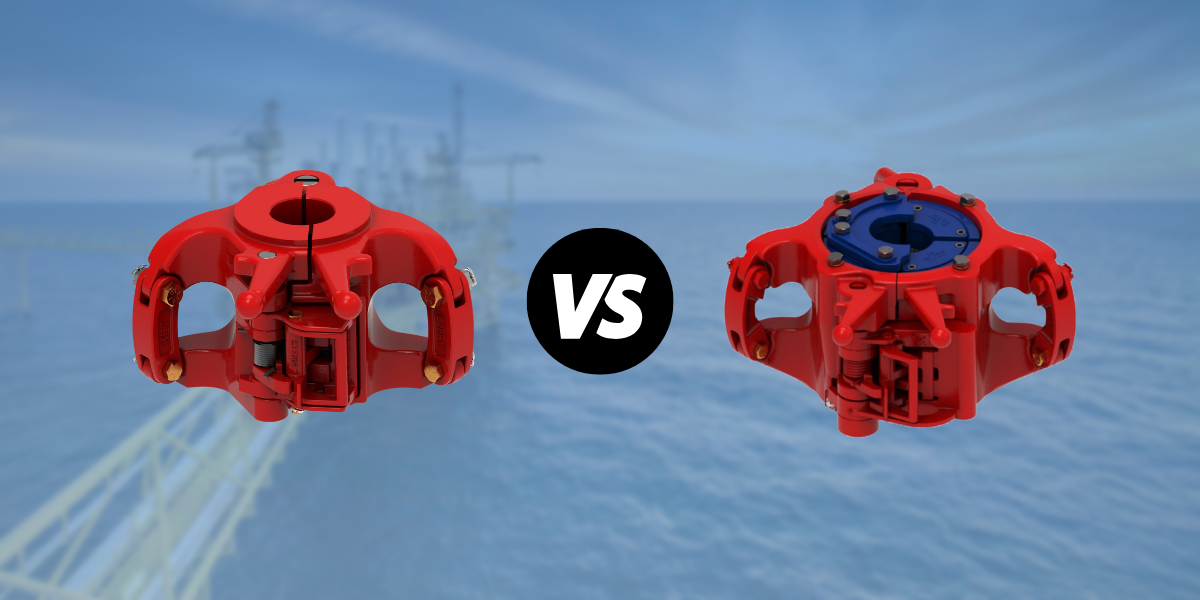
In the drilling industry, elevators are hinged devices used to lift and lower drill pipe, casing, drill collars, and tubing. Their use is essential, and any maintenance issues can bring drilling to a halt. Therefore, it’s necessary to understand the differences between types of elevators and when their use is appropriate. Below, we’ve provided an overview of the 6 differences between G and Y series elevators.
- Purpose
- Tonnage / Capacity
- Daily Maintenance
- Semi-Annual and Annual Maintenance
- Elevator Wear
- Troubleshooting
Purpose
Y series elevators are a kind of slip type elevator. Slips inside the elevator are used to grip and hold the tubular while hoisting in or out of the hole. Y series elevators are used for hoisting tubing, and small casing when the appropriate sized slip and setting ring are installed. They serve to avoid gouge damage and bottlenecking.
G series elevators are a kind of center latch elevator. They have an 18 degree taper, and are used for handling drill pipe and tools. Due to their design, they should be used only on tool joints with an 18 degree taper
Tonnage / Capacity
G series elevators have a higher ton capacity, with some models reaching up to 750 tons. Y series elevators typically have a maximum capacity of around 200 tons.
Daily Maintenance
Both G and Y Series elevators require similar daily maintenance checks. These include visually inspecting for cracks, loose fits or connections, elongation of parts, and other signs of wear, corrosion, or overloading. The hinge pin, latch pin, and latch lock pin should be checked for wear. This may inhibit proper closing of the door and latch lock engagement. The latch lock should be checked for proper engagement.
Springs should be checked for damage, deformation, and lack of tension. Y series elevators also require testing the slip and slip springs to make sure there is enough tension to correctly operate the slips. The setting plate also needs to be checked for wear, damage, or deformations including proper movements. The setting plate should have movement is required to allow the slips to move freely up and down without jamming.
Semi-Annual and Annual Maintenance
Prior to semi-annual and annual inspections, all foreign material such as dirt, paint, grease, oil, scale, etc. shall be removed from the concerned parts by suitable method of blasting, paint stripping, or stem-cleaning).
Twice a year, both G and Y series elevators Require a Magnetic Particle Inspection (MPI to be performed on all primary carrying components. For G series elevators, the taper angle and thru bore dimension should be verified including the pins. For Y series elevators, pins and springs should be checked for wear, damage, and corrosion.
Annual maintenance for both series elevators are the same. They include conducting a performance load test, MPI test, and dimensional inspection. Repairs should be made if necessary by an authorized KET repair facility.
Elevator Wear
As mentioned above, the G series elevator can be affected by the wear of the bore. Specifically, the taper can wear and provide less contact area to support the tubular. It’s important to measure the angle of the taper in multiple areas, as the taper doesn’t wear evenly.
Both types of elevators should have their ear radius and dimensions checked as well, as the wear on this can affect the load the elevator can support. If the dimension is below the minimum as specified by the manufacturer, the elevators should be scrapped as this is not a repairable area.
Troubleshooting
The G and Y series have a lot in common when it comes to troubleshooting. Both can suffer from deformed pin holes and bent pins, resulting from excessive use and wear. Elevators not opening properly can be a result of corrosion, while doors not closing can be a result of an oversized tubular or weak latch and latch lock springs.
However, Y series elevators also suffer from their slips not moving freely. This can result from an incorrect or weak slip spring, bent slip bolt, a bind in the setting plate, or an issue with installation. During installation, slip springs may pop out and need to be re-inserted into their cavity. Long screwdrivers are also used to temporarily hold a slip in place before reinstalling the bolt assembly, and can result in a non-moving slip if the reinstallation is not completed properly.
Keystone Drill Pipe Elevators
KET is a leading manufacturer of Drill Pipe Elevators. We design and precision-machine all of our elevators to meet and exceed API Standards (API 8C or API 7K Standards), with KET and the API monogram stamped on our equipment, you can be sure you are getting high-grade equipment at a competitive price, made in the USA.
We understand the critical requirements of the oil and gas industry and the need for high-quality tools and parts.
Our equipment is manufactured from quality materials acquired from trusted vendors. *Upon purchase, customers receive proof of load test, MPI, and material and heat-treatment certifications included with their data packets.
About Keystone Energy Tools
 Keystone Energy Tools is a manufacturer with over fifty years of combined experience in designing, manufacturing, and delivering high-quality oilfield tools, including elevators, slips, dies and inserts, tongs dies, safety clamps, stabbing guides, drill pipe float valves, baffle plates, float valve pullers, rotating mouseholes, and tong blocks.
Keystone Energy Tools is a manufacturer with over fifty years of combined experience in designing, manufacturing, and delivering high-quality oilfield tools, including elevators, slips, dies and inserts, tongs dies, safety clamps, stabbing guides, drill pipe float valves, baffle plates, float valve pullers, rotating mouseholes, and tong blocks.
By using the latest in 3D modeling for product design and by staying current with the rapid advances in manufacturing technology and quality-assurance standards, Keystone is able to manufacture and produce the most reliable products on the market today. All Keystone Handling Tools are manufactured according to API 8C and API 7K Standards.


